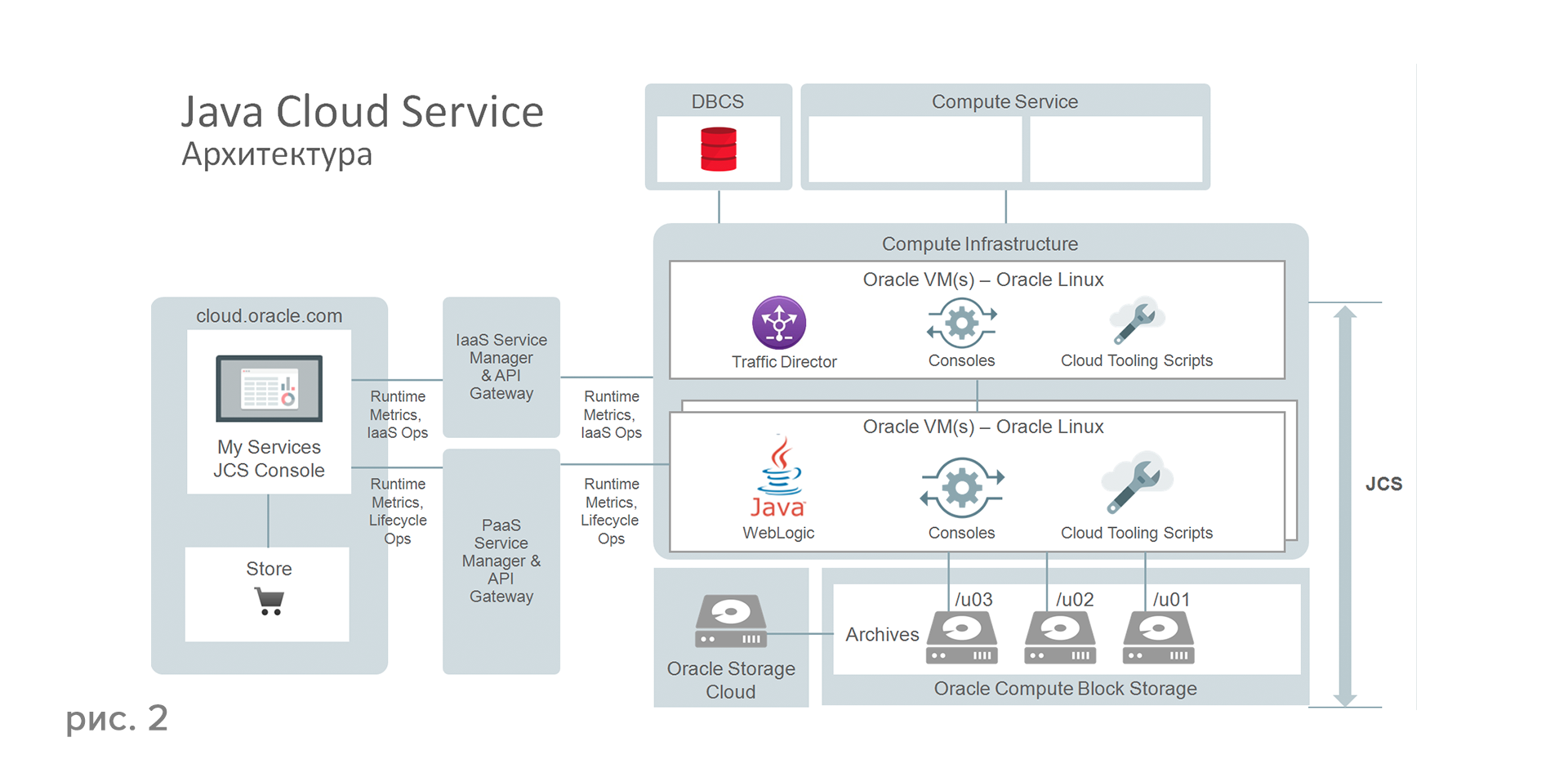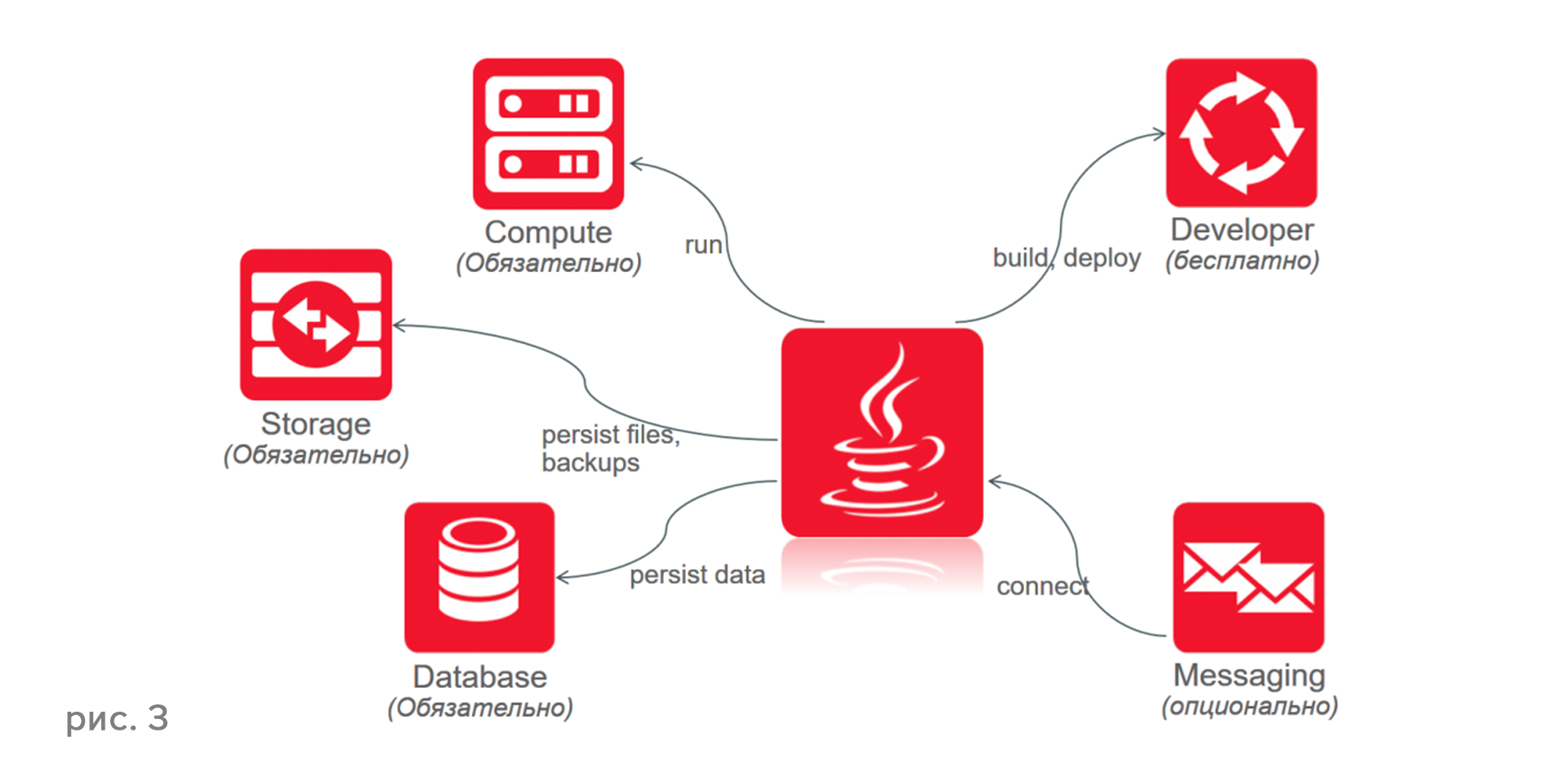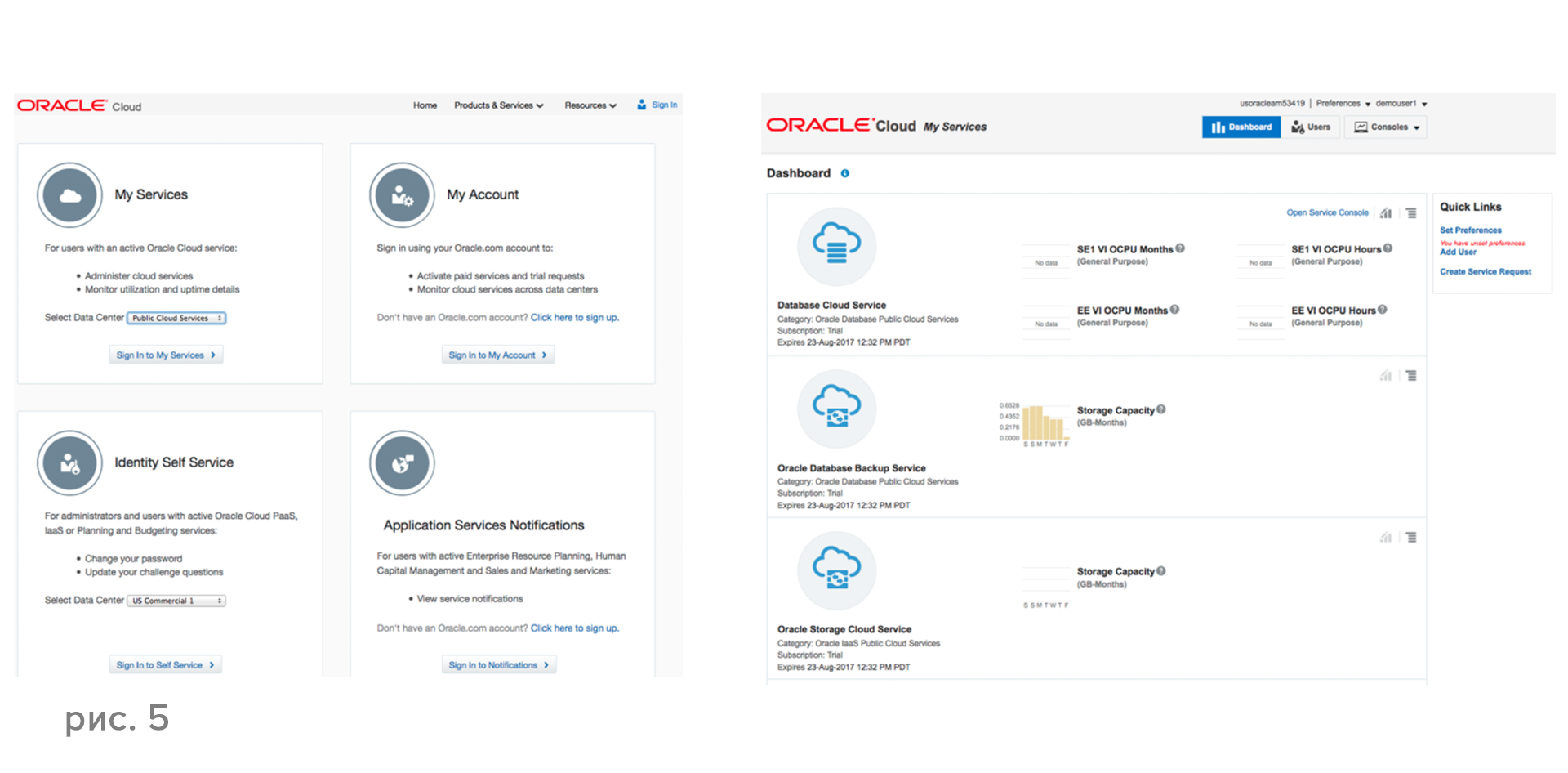How to migrate to Oracle Java Cloud in 1.5 hours?
Today, all the major software developers offer public cloud services. Oracle company did not immediately join this race, but today it has already caught up and overtakes the rest of the market players. The legend of Silicon Valley, one of the founders of the Oracle Corporation, Larry Ellison, recently said that in terms of sales growth, Oracle's cloud services are now showing such dynamics that the Oracle Database sales did not show at the best of times. So now all the company's attention is concentrated on the clouds.

What is Oracle's public cloud today? This is a fully integrated service that covers the entire planet both in terms of hosting cloud data centers, in terms of accessibility, and ... includes the best Oracle solutions. The cloud platform is built (see Figure 1) on the engineering systems of Oracle Exalogic and Oracle Exadata and includes the Oracle Database, the world's leading WebLogic Server application server version 12.1.3, - on the agenda of 12.2.1, the latest and most advanced release Oracle Application Server, as well as In-Memory Data Grid (IMDG) Coherence solutions and others. Traffic balancing is done using the Oracle Traffic Director.

')
Java Cloud Service (JCS) is a full-featured Internet resource with Oracle DataBase, WebLogic, Coherence with access to virtual machines through various protocols, including SSH. JCS exists in two versions. The full version, which includes everything that is needed for full-fledged work, is based on Oracle Linux with a choice of Standard Edition (SE), Enterprise Edition (EE) and Suite. The version of Virtual Image does not provide access to the virtual machine.
The service allows you to implement any Java Enterprise Edition - applications and build complex three-layer domains in both test and cluster solutions. Lifecycle management is fully automated. A variety of developer tools - JDeveloper, Eclipse, NetBeans - are integrated with the cloud service.
What is the Java Cloud Service for? The main area of application of the Java Cloud Service is development, testing, deployment in the cloud. The cloud is perfect for testing, because the cloud does not need its own resources, does not need administration, does not need to buy licenses, you only need space on the cloud to host the application and test it. Another application of the service is the migration of applications to the cloud. Due to the absence of costs for data centers and the maintenance of a three-layer architecture, migration allows you to significantly reduce costs: you do not need to manage the structure and regulations, backup and recovery, manage load balancing, updates, etc.

Figure 2 shows the architecture of the Java Cloud Service cloud. At the very top is the Load Balancer Cluster, which is represented by the product Oracle Traffic Director. The center and main foundation of all applications is the WebLogic application server (11g or 12c). Coherence is a cache solution to speed up transactions, you can use it in your solution if necessary.

When creating a cloud, the sequence of actions is important. For example, you can not create a cloud without a database. It is impossible without Storage - this is the place where backup copies will be stored, etc. You cannot create a cloud without Compute service, which will be engaged in calculations. Thus, you first need to create Storage, Database and Compute. Everything else (Figure 3) is optional.
All work on changing and modifying all resources is done automatically. You see the appearance of a new system update and decide which changes to accept and which not, which ones to roll back, etc. Thus, administration is reduced to using the console. Backups and restores are performed in the same way, you can change the backup depth, configuration, log, perform restores with a rather deep history.
Oracle Developer Cloud Service is a complete cloud-based development platform, managing all application life cycles, projects, and development teams.
What is it for? In order not to buy software and equipment for a new project, not to hire administrators to manage projects and teams, and not to integrate with development environments. The Developer Cloud Service (Figure 4) is a development platform that includes tools for managing the application lifecycle, managing projects and development teams, and managing deployments and deployments. The solution for iTracking and targeted project management is built directly into the Developer Cloud.

The advantages of the Developer Cloud Service are self-explanatory: an intuitively simple installation of all components, rapid adaptation of the development team to a new environment and reduced management costs lead to an increase in the effectiveness of the development team and simplified management of the team.
We list the key steps that need to be performed in order to migrate an application in an hour and a half.
Figure 5, on the left, displays the Oracle Cloud start page. On this page you choose your data center. Figure 5, on the right, is the first control page, called the Dashboard. There are several ways to create a new WebLogic domain - you can choose between creating Oracle Cloud Virtual Image or a full-fledged Oracle Java Cloud Service and choose the billing options you need, the version of WebLogic, accept or reject Coherence, the number of managed servers, memory sizes for them, etc. After you answer all the questions, the WebLogic domain will be created.

It will take you about 40 minutes to create the database. After you have created the database, it will take about 20 minutes to create a full-fledged WebLogic domain with a full set of resources and tools. Depending on the complexity of the application and the size of the database, it takes about 30 minutes to deploy the application - as a result, as promised in the article title, a full migration to the cloud will take you about 1.5 hours.
You are also provided with Enterprise Manager, a standard management tool for monitoring, monitoring, and performing all necessary administrative functions. In fact, migrating to the cloud, you get a complete set of infrastructure tools, similar to the one that you build yourself in data centers - including managing users that you can add, delete, etc.
Today, all the major software developers offer cloud services. According to a recent study in the next five years, approximately 80% of all IT services migrate to the clouds! Therefore, competition in this market is growing exponentially. This will lead to a change in the competitive environment among users - after all, those who migrate to the cloud earlier than others and learn how to use the benefits of cloud technologies will free up funds that have to be spent on supporting the work of applications in data centers, and will receive serious competitive advantages. Therefore, it is necessary right now to prepare for these changes and test the possibilities offered by the latest cloud platforms.

What is Oracle's public cloud today? This is a fully integrated service that covers the entire planet both in terms of hosting cloud data centers, in terms of accessibility, and ... includes the best Oracle solutions. The cloud platform is built (see Figure 1) on the engineering systems of Oracle Exalogic and Oracle Exadata and includes the Oracle Database, the world's leading WebLogic Server application server version 12.1.3, - on the agenda of 12.2.1, the latest and most advanced release Oracle Application Server, as well as In-Memory Data Grid (IMDG) Coherence solutions and others. Traffic balancing is done using the Oracle Traffic Director.

')
Java Cloud Service
Java Cloud Service (JCS) is a full-featured Internet resource with Oracle DataBase, WebLogic, Coherence with access to virtual machines through various protocols, including SSH. JCS exists in two versions. The full version, which includes everything that is needed for full-fledged work, is based on Oracle Linux with a choice of Standard Edition (SE), Enterprise Edition (EE) and Suite. The version of Virtual Image does not provide access to the virtual machine.
The service allows you to implement any Java Enterprise Edition - applications and build complex three-layer domains in both test and cluster solutions. Lifecycle management is fully automated. A variety of developer tools - JDeveloper, Eclipse, NetBeans - are integrated with the cloud service.
What is the Java Cloud Service for? The main area of application of the Java Cloud Service is development, testing, deployment in the cloud. The cloud is perfect for testing, because the cloud does not need its own resources, does not need administration, does not need to buy licenses, you only need space on the cloud to host the application and test it. Another application of the service is the migration of applications to the cloud. Due to the absence of costs for data centers and the maintenance of a three-layer architecture, migration allows you to significantly reduce costs: you do not need to manage the structure and regulations, backup and recovery, manage load balancing, updates, etc.

Figure 2 shows the architecture of the Java Cloud Service cloud. At the very top is the Load Balancer Cluster, which is represented by the product Oracle Traffic Director. The center and main foundation of all applications is the WebLogic application server (11g or 12c). Coherence is a cache solution to speed up transactions, you can use it in your solution if necessary.

When creating a cloud, the sequence of actions is important. For example, you can not create a cloud without a database. It is impossible without Storage - this is the place where backup copies will be stored, etc. You cannot create a cloud without Compute service, which will be engaged in calculations. Thus, you first need to create Storage, Database and Compute. Everything else (Figure 3) is optional.
All work on changing and modifying all resources is done automatically. You see the appearance of a new system update and decide which changes to accept and which not, which ones to roll back, etc. Thus, administration is reduced to using the console. Backups and restores are performed in the same way, you can change the backup depth, configuration, log, perform restores with a rather deep history.
Developer cloud service
Oracle Developer Cloud Service is a complete cloud-based development platform, managing all application life cycles, projects, and development teams.
What is it for? In order not to buy software and equipment for a new project, not to hire administrators to manage projects and teams, and not to integrate with development environments. The Developer Cloud Service (Figure 4) is a development platform that includes tools for managing the application lifecycle, managing projects and development teams, and managing deployments and deployments. The solution for iTracking and targeted project management is built directly into the Developer Cloud.

The advantages of the Developer Cloud Service are self-explanatory: an intuitively simple installation of all components, rapid adaptation of the development team to a new environment and reduced management costs lead to an increase in the effectiveness of the development team and simplified management of the team.
How to build Oracle Java Cloud Service
We list the key steps that need to be performed in order to migrate an application in an hour and a half.
- Sign up for a trial version of Public Cloud.
- Install CloudBerry Explorer for OpenStack Storage to create containers.
- Create an SSL Key to access cloud-based virtual machines.
- Using CloudBerry Explorer for OpenStack Storage, create two containers:
- container for the weblogic domain
- container for databases .
- Log in to the cloud via the console.
- Create a database.
- Create a WebLogic domain.
Figure 5, on the left, displays the Oracle Cloud start page. On this page you choose your data center. Figure 5, on the right, is the first control page, called the Dashboard. There are several ways to create a new WebLogic domain - you can choose between creating Oracle Cloud Virtual Image or a full-fledged Oracle Java Cloud Service and choose the billing options you need, the version of WebLogic, accept or reject Coherence, the number of managed servers, memory sizes for them, etc. After you answer all the questions, the WebLogic domain will be created.

It will take you about 40 minutes to create the database. After you have created the database, it will take about 20 minutes to create a full-fledged WebLogic domain with a full set of resources and tools. Depending on the complexity of the application and the size of the database, it takes about 30 minutes to deploy the application - as a result, as promised in the article title, a full migration to the cloud will take you about 1.5 hours.
You are also provided with Enterprise Manager, a standard management tool for monitoring, monitoring, and performing all necessary administrative functions. In fact, migrating to the cloud, you get a complete set of infrastructure tools, similar to the one that you build yourself in data centers - including managing users that you can add, delete, etc.
Conclusion
Today, all the major software developers offer cloud services. According to a recent study in the next five years, approximately 80% of all IT services migrate to the clouds! Therefore, competition in this market is growing exponentially. This will lead to a change in the competitive environment among users - after all, those who migrate to the cloud earlier than others and learn how to use the benefits of cloud technologies will free up funds that have to be spent on supporting the work of applications in data centers, and will receive serious competitive advantages. Therefore, it is necessary right now to prepare for these changes and test the possibilities offered by the latest cloud platforms.
Source: https://habr.com/ru/post/274319/
All Articles